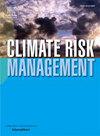Communicating the risk of erosion: the effects of map-based communication on risk perception and affect
IF 5
2区 环境科学与生态学
Q1 ENVIRONMENTAL SCIENCES
引用次数: 0
Abstract
This study firstly aims to understand the impacts of map representations of coastal erosion on risk perception and affects of lay citizens. Secondly, it aims to study the effect of differing design of cartographic features on observation and interpretation of the message conveyed by different maps. Seven maps were presented to the participants (N = 50), varying according endogenous (abstraction, regalian cartridge) and exogenous characteristics (background, colours). A questionnaire interrogated risk perception and affect before and after observation, while eye-tracking data were recorded during the observation of each map. This experiment shows that communicating erosion risk by maps reduces perceived knowledge of risk but also reduces fear of the risk. The abstraction level significantly impacts observation patterns: correlation maps seem to guide visual attention in a more relevant way and to convey the message more clearly and effectively than other types of maps. But there is no influence of the other characteristics even if interviews show that colours seem to influence the message interpretation.
传达侵蚀风险:基于地图的沟通对风险感知和影响的影响
本研究首先旨在了解海岸侵蚀地图表征对非专业公民风险感知和影响的影响。其次,研究不同地图学特征的设计对观察和解读不同地图所传达信息的影响。向参与者(N = 50)展示了七张地图,根据内源性(抽象,帝王墨盒)和外源性特征(背景,颜色)而变化。通过问卷调查,对观察前后的风险感知和影响进行调查,同时在观察每张地图的过程中记录眼动数据。这个实验表明,通过地图传达侵蚀风险减少了对风险的认知,但也减少了对风险的恐惧。抽象水平显著影响观察模式:相关性图似乎以一种更相关的方式引导视觉注意力,并且比其他类型的图更清晰有效地传达信息。但是,即使采访显示颜色似乎影响了信息的解释,其他特征也没有影响。
本文章由计算机程序翻译,如有差异,请以英文原文为准。
求助全文
约1分钟内获得全文
求助全文
来源期刊

Climate Risk Management
Earth and Planetary Sciences-Atmospheric Science
CiteScore
8.20
自引率
4.50%
发文量
76
审稿时长
30 weeks
期刊介绍:
Climate Risk Management publishes original scientific contributions, state-of-the-art reviews and reports of practical experience on the use of knowledge and information regarding the consequences of climate variability and climate change in decision and policy making on climate change responses from the near- to long-term.
The concept of climate risk management refers to activities and methods that are used by individuals, organizations, and institutions to facilitate climate-resilient decision-making. Its objective is to promote sustainable development by maximizing the beneficial impacts of climate change responses and minimizing negative impacts across the full spectrum of geographies and sectors that are potentially affected by the changing climate.
 求助内容:
求助内容: 应助结果提醒方式:
应助结果提醒方式:


